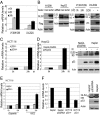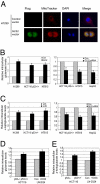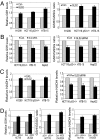Glutaminase 2, a novel p53 target gene regulating energy metabolism and antioxidant function
- PMID: 20378837
- PMCID: PMC2867677
- DOI: 10.1073/pnas.1001006107
Glutaminase 2, a novel p53 target gene regulating energy metabolism and antioxidant function
Abstract
Whereas cell cycle arrest, apoptosis, and senescence are traditionally thought of as the major functions of the tumor suppressor p53, recent studies revealed two unique functions for this protein: p53 regulates cellular energy metabolism and antioxidant defense mechanisms. Here, we identify glutaminase 2 (GLS2) as a previously uncharacterized p53 target gene to mediate these two functions of the p53 protein. GLS2 encodes a mitochondrial glutaminase catalyzing the hydrolysis of glutamine to glutamate. p53 increases the GLS2 expression under both nonstressed and stressed conditions. GLS2 regulates cellular energy metabolism by increasing production of glutamate and alpha-ketoglutarate, which in turn results in enhanced mitochondrial respiration and ATP generation. Furthermore, GLS2 regulates antioxidant defense function in cells by increasing reduced glutathione (GSH) levels and decreasing ROS levels, which in turn protects cells from oxidative stress (e.g., H(2)O(2))-induced apoptosis. Consistent with these functions of GLS2, the activation of p53 increases the levels of glutamate and alpha-ketoglutarate, mitochondrial respiration rate, and GSH levels and decreases reactive oxygen species (ROS) levels in cells. Furthermore, GLS2 expression is lost or greatly decreased in hepatocellular carcinomas and the overexpression of GLS2 greatly reduced tumor cell colony formation. These results demonstrated that as a unique p53 target gene, GLS2 is a mediator of p53's role in energy metabolism and antioxidant defense, which can contribute to its role in tumor suppression.
Conflict of interest statement
The authors declare no conflict of interest.
Figures







Comment in
-
Alternative fuel--another role for p53 in the regulation of metabolism.Proc Natl Acad Sci U S A. 2010 Apr 20;107(16):7117-8. doi: 10.1073/pnas.1002656107. Epub 2010 Apr 14. Proc Natl Acad Sci U S A. 2010. PMID: 20393124 Free PMC article. No abstract available.
-
Journal club. A cancer biologist weighs up p53, metabolism and cancer.Nature. 2010 Aug 19;466(7309):905. doi: 10.1038/466905d. Nature. 2010. PMID: 20725003 No abstract available.
References
-
- Vousden KH, Prives C. Blinded by the light: The growing complexity of p53. Cell. 2009;137:413–431. - PubMed
-
- Levine AJ, Hu W, Feng Z. The P53 pathway: What questions remain to be explored? Cell Death Differ. 2006;13:1027–1036. - PubMed
-
- Matoba S, et al. p53 regulates mitochondrial respiration. Science. 2006;312:1650–1653. - PubMed
-
- Bensaad K, et al. TIGAR, a p53-inducible regulator of glycolysis and apoptosis. Cell. 2006;126:107–120. - PubMed
Publication types
MeSH terms
Substances
Grants and funding
LinkOut - more resources
Full Text Sources
Other Literature Sources
Medical
Molecular Biology Databases
Research Materials
Miscellaneous

